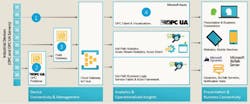What the Developing Microsoft-OPC UA Relationship Means to You
At Hannover Messe this year, I reported on developments in the Microsoft/OPC Foundation relationship to “enable virtually any Industrial Internet of Things (IIoT) scenario through interoperability between the millions of applications and industrial equipment compliant with the OPC UA standard.” (See the report here.) As described by Sam George, partner director for Microsoft Azure IoT, the OPC UA-related open source software stack showcased at Hannover Messe enables deep integration with Azure IoT, as well as the Universal Windows Platform (UWP), including advanced command and control (which is sure to freak out a great deal of people concerned with the remote control cybersecurity aspects of IIoT) as well as data analytics capabilities in the cloud.
The announcement at Hannover Messe was, apparently, a set up for more Microsoft/OPC UA connections, as Microsoft has also now released a new open-source reference stack. This .NET Standard reference stack will reportedly work on all common software platforms in the market today, allowing for the creation of OPC UA clients, servers and OPC Publishers (for sending telemetry data to the cloud) on Windows Vista, 7, 8, 8.1, 10, iOS, Linux and Android platforms. It will also enable OPC clients and servers to run directly on Azure. Because the architecture underlying Azure already uses the upcoming Publisher/Subscriber OPC specification extension and contains a sample application called OPC Publisher, George says users can directly connect devices to existing OPC UA servers and send OPC UA telemetry data to Azure IoT for analysis and machine learning in the cloud.
“Building and maintaining an industry-grade reference stack is a significant undertaking,” says George. “It provides a single code base for all common platforms and is absolutely critical to reduce costs and maintain efficiencies. As developers use and contribute to this stack, it has the potential to vastly increase the share of OPC-enabled devices and create benefits across a broad ecosystem.”
What all this boils down to for users is easing the process of adopting IIoT and Industrie 4.0 initiatives. With the level of interoperability enabled via the .NET Standard reference stack, users can create “entirely new value propositions, such as identifying quality issues early in the manufacturing process through machine learning algorithms,” George says. “Machine builders can offer new business models such as machine-as-a-service or process-as-a-service, shifting from product centricity to customer-oriented, solution-centric value propositions. In addition, field service personnel can use mixed reality devices to converge 3D virtual information and real time data with physical systems to fix and optimize equipment.”
In regard to the remote control capabilities mentioned above vis-à-vis the OPC UA/Azure integration, George recognizes that addressing security concerns around this capability will be paramount. “When we first sat down with the OPC Foundation and discussed the integration of OPC UA into the Azure IoT Suite, we knew that getting security right would be the most important part—especially since we’re enabling the command and control of OPC UA devices on premise from the cloud,” he says. “We employ a wide range of security capabilities in our design, including service-assisted communication, WebSockets for outbound communication, and TLS encryption. We continue to work with the OPC Foundation to simplify building secure systems based on OPC UA, as well as share best practices with the community.”
About the Author
David Greenfield, editor in chief
Editor in Chief

Leaders relevant to this article:
